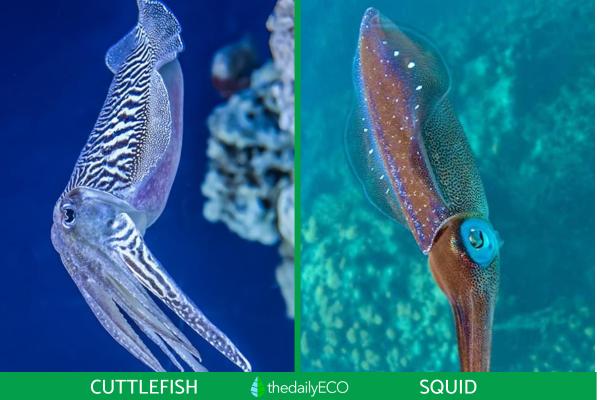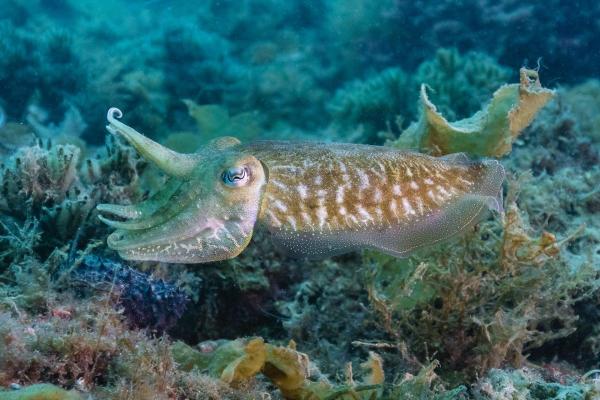Difference Between Squid and Cuttlefish


The diversity of marine life is incredible, much of which has yet to be explored or even seen with human eyes. What we do know has been based on many years of meticulous and often dangerous research thanks to the perils of the ocean depths. Fortunately, we have been able to discover and taxonomically rank many of the marine life found lurking below. One group of marine animals which inspire some of the greatest intrigue is those known as cephalopods. These mollusks are known for their prominent head, tentacles and other fascinating characteristics.
Although there are similarities, some of these cephalopods have very specific features which make them easy to distinguish once you know them. thedailyECO explains more about some of them with our comparison on the difference between squid and cuttlefish.
Squid characteristics
To better understand the differences between squid and cuttlefish, we can look at these two cephalopods in greater individual detail. We start by looking at the characteristics of squid:
- Squid are marine mollusks with an elongated body. They are known for their great range of size since some can be as little as 4" long and others can be as much as 60 feet long. The size depends on the species, but they have inspired legends of giant squid that attack boats such as kraken.
- They have three hearts, one systemic and two branchial. This is the same for cuttlefish. The number is so high because their blood is not the same as ours, so they have to move it faster in order to filter it efficiently. The molecule in their blood is known as hemocyanin, making their blood blue in color.
- It has the ability to camouflage by changing the color of its skin.
- They can emit clouds of ink which is most often used as a defense mechanism to evade potential predators.
- Some species can emit light with the help of symbiotic bacteria. Learn more with our guide to symbiosis in biology.
- To move they have an organ called the hyponome, which is used to create jet pressure. They do not have an organ which is used for floatation.
- Like cuttlefish, squids use their tentacles, beak and camouflage to obtain food. In addition to feeding on fish, other mollusks and crustaceans, larger species may feed on prey of proportional size.
- Squid are a favorite food of sperm whales, birds, fish and sharks. Some may have nocturnal habits to avoid being preyed on or may even hide under the sand or between rocks.
- Their reproduction includes courtship processes by males by changing the color of their skin. Groups of squid are created until pairs are found to procreate. The eggs of the females are laid in places hidden from their predators, although only a small part of them will survive. They have a strategy of producing many eggs, taking into account the low survival rate. There is also no parental care, so newborns have to fight on their own to exist.

Cuttlefish characteristics
Cuttlefish are also mollusks which have certain similarities to squid. You can find out what they are with our list of the following cuttlefish characteristics:
- Cuttlefish are marine mollusks without an external shell. They are flattened with frilled edges on their body, under which 10 extensions emerge (two tentacles and eight limbs).
- They measure between 4 to 20" in length.
- Cuttlefish feed with the help of their two tentacles, capturing their prey and taking it to their mouth where they use their razor sharp beak to crush them to death. They have neurotoxins that are released in their beaks to numb or kill their prey. You may think they have more tentacles, but this is not the case. Like squid, they have two tentacles and eight arms.
- They can change their skin color to hide from predators or to hunt down their prey. Cells that change color are called chromatophores. They have a voluntary control for this color change. They can even create games of colors camouflaged against the direction of their environment so a predator does not understand in which direction they are moving.
- Among its diet we can see fish, other mollusks or crabs, similar to the squid. In some cases they can even have cannibalistic behaviors, consuming organisms of their own species.
- They can be preyed on by dolphins, fish, seals and cartilaginous fish larger than themselves, such as sharks.
- In addition to the aforementioned methods of defense, they can also emit black ink to defend themselves or distract predators, just as the squid can do.
- They have separate sexes, i.e. there are males and females. Their fertilization is internal and they are oviparous as they lay eggs.

What are the differences between squid and cuttlefish?
As you can see, there are many similarities between squid and cuttlefish. They Both have two tentacles and eight arms, they both can squirt ink to defend themselves and they have similar diets. However, there are some key characteristics which allows us to differentiate between a squid vs. cuttlefish:
- The first difference between cuttlefish and squid lies in their taxonomy. Squids belong to the order Teuthoidea and cuttlefish to the order Sepiida.
- Perhaps the greatest difference between squid and cuttlefish is the most obvious as it refers to their body shape. This is because squid have a more hydrodynamic shape and are elongated. Cuttlefish are shorter and rounder.
- Another important difference lies in the skeletal system of these cephalopods. Cuttlefish have a large internal structure known as a cuttlebone made of porous aragonite. This gives it buoyancy and they can control the proportions of gases and liquids within this structure. By contrast, squids have a gladius, also known as a pen. It is elongated in shape and is transparent as it is made of chitin. It has a different function than the cuttlefish bone as it serves to give the squid rigidity.
- Because of these physical characteristics, the movement of the squid vs. cuttlefish is different. Cuttlefish move with undulations of their body and practically float along. Squid move mainly by jet propulsion and have to invest a lot of energy to compensate for their negative buoyancy due to the lack of a buoyancy organ.
- For the above reason, squid are faster and cuttlefish are slower .
- In their anatomy we can also distinguish differences in their eyes. Cuttlefish have a W-shaped pupil, while squid have a round pupil.
- The cuttlefish's habitat is more restricted. They prefer warm, shallow marine waters. In contrast, squid can live in very deep and cold areas. Learn more about the habitats of these marine animals by looking at the different types of aquatic ecosystems.
- Cuttlefish are smaller as they only generally reach up to 20" in length, but squid can become gigantic. This doesn't include individual species of squid which may be smaller than many cuttlefish.
Now you know the differences between cuttlefish vs. squid, you may want to learn some more fascinating facts about marine animals. You can do so by checking out our article on whether dolphins like to get high.
If you want to read similar articles to Difference Between Squid and Cuttlefish, we recommend you visit our Wild animals category.
- Agri-Food and Fisheries Information Service. (2019). Squid: three-hearted mollusk. Retrieved from: https://www.gob.mx/siap/articulos/el-calamar-molusco-de-tres-corazones?idiom=es
- Beatty, R., Beer, A., & Deeming, C. (2010). The book of nature. Great Britain: Dorling Kindersley.
- Gómez-Pompa, A., Barrera, A., Gutiérrez-Vázquez, J., & Halffter, G. (1980). Biology: Unity, Diversity and Continuity of Living Beings. Mexico City: National Council for the Teaching of Biology.
- Compton, A., & L. Wiley. (2011). Sepia officinalis. Retrieved from: https://animaldiversity.org/accounts/Sepia_officinalis/







